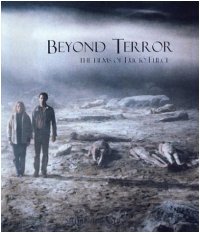
Written by Stephen Thrower.
Published by FAB Press (ISBN 0-9529260-6-7) 2002.
- Reviews and filmography of the works of Italian director Lucio Fulci. Described as the Godfather of Italian horror, he is a strongly debated director who produced works that are equally described as brilliant and pure exploitative trash. As well as his famous horror works, Zombi 2 (1979) and The Beyond (1981), he filmed Spaghetti Westerns, action films and even a collection of sex comedies.
- The
book takes each of Fulci's film in turn (in chapters curiously aranged
by genre rather than the more typical chronological order). Each
chapter opens with a compilation of discussion of the films contained
within, while the pages for films themselves include a complete
synopsis followed
by a review/commentary. The chapter openings contain a lot of
interesting information, about the films, genres and the actors, but it
does end up on a lot of tangents. The reviews are interesting, and
although some might not agree with his analyses, there are various
interesting quotes about the films. It is clear that Thrower has a
bias towards Fulci's
horror films, and his less well known, but equally important and
interesting films like Conquest (1983), Contraband (1980) and Four of the Apocalypse
(1974) get very minor mentions. The layout of the book itself
is rather annoying with excessive use of illustrations, leading to
whole
pages of pictures breaking up sections of text, and a very distracting
use of bold highlighting for film's titles, rather than the more conventional italics.
- Although of interest to fans of the director with details of some of his lesser known titles as well as the most famous ones, the book does suffer from a bad layout - and a lot of the interesting information gets lost in the format. Partly recommended.
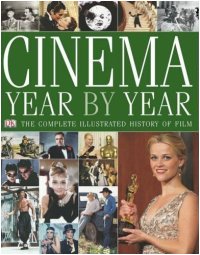
Edited by Robyn Karney and Joel W. Finler.
Published by DK (ISBN 1405316535 (UK) and 075662259X (USA)) 2006.
- A newspaper/journal style history of cinema from its earliest days.
- The
book is split into individual years (from 1894 - 2006) - with each year
having about 10 pages laid out like a newspaper containing reports on
key films and developments during that year and illustrated with
appropriate pictures, along with a list of births/deaths and Oscar
winners (where appropriate). The general focus of the book is on
mainstream American (ie. Hollywood) and arthouse European (eg. Bergman,
Pasolini, Fellini etc.) films, and there is some mention of Japanese
and wider world cinema - sadly cult films are generally overlooked,
directors like Mario Bava and Terence Fisher not even getting a mention.
- Not one for the die hard cult movie fans or for anyone looking for in depth detail on a film, actor or genre; Cinema Year by Year is however a useful reference book and an interesting way to discover new films to watch.
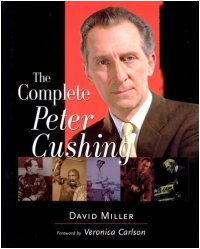
Written by David Miller.
Published by Reynolds and Hearn (ISBN 1-90311-93-5) 2005.
- A complete biography and filmography of the mild mannered British actor. Best known for his Hammer Horror works, Peter Cushing starred in over 90 films ranging from adventures, comedies and actions films, to arguably the most important film ever made - Star Wars (1977).
- The
book is very well researched with extensive details of Cushing's life
and career, notably including information on his less frequently documented pre-Hammer
work, and it provides detailed notes on all of his major and lesser known
films. Presented in a chronological prose style, it is useful for both
reference and casual reading and includes plenty of quotes from
interviews with fellow actors and directors. Miller does choose to make
some editorial comments about the films, which some people might find a
little annoying, but they are minimal and flow well with the text. The
book is nicely illustrated throughout, with a centre section of colour
images.
- Highly recommended to fans of Peter Cushing, this book provides interesting background to his best known performances and interesting information on some lesser known roles that are worth tracking down.
- For more information on the actor and his films, see our Peter Cushing reviews page.

Written by Wayne Kinsey
Published by Reynolds and Hearn (ISBN 1-903111-44-7) 2005.
- The history of Hammer Films, from their early beginnings to 1966. The British studio best known for their classic horror films, including The Curse of Frankenstein (1957), actually started making films in the 1930s, and again after the war in the late 1940s, including a variety of adventure, comedy and war-time action films.
- It
is clear from a cursory glace that the
book is very well researched - details are provided on every stage of a
film's development, from early scripting notes, to casting, filming,
post production, and the all controlling reign of the censors at the
BBFC, including various quotes from interviews and newspapers where
appropriate. Although the horror films from 1955 onwards are given the
main focus, there are plenty of details on the studio's origins, and on
the various non-horror productions over the years. Although the book is
very much a reference work (the author avoids any editoral reviews of
the films), it is laid out in a prose style, with a seperate chapter
for each year, making it easy to read through, but sometimes awkward to
find specific details on a film in a hurry. The book is lightly
illustrated, mostly with publicity and behind-the-scenes photographs.
- Highly recommended to fans of Hammer Studios, it is highly detailed but quite easy to read through - making it ideal for new fans and old hands. A follow-up book for 1967 onwards will be released in 2007.
- Find more information on the studio at our Hammer Films reviews page.

Written/Edited by Paul Cronin
Published by Faber and Faber (ISBN 0-571-20708-1) 2003.
- A book of interviews with director Werner Herzog. Considered by many to be the one of the best directors in contemporary cinema, he has directed such varied films as jungle adventure Aguirre: The Wrath of God (1972), a study of the American dream, Stroszeck (1977) and the ultimate in bizarre cinema Even Dwarfs Started Small (1971).
- The
book is well written, with Cronin's questions kept to a minimum and so
most of the text is comprised of Herzog's stories and opinions of his
own films. Nicely arranged, the book is very easy to read and contains
a lot of very interesting information, especially about his early life,
his work with Klaus Kinski and Bruno S., a and although obviously
one-sided, it helps to dispell a lot of the myths surrounding his works
and actions. On the negative side it is slightly out of date now (it
does not mention his works post-2004) and does not probe as deeply as some readers might hope.
- Highly recommended to anyone who has an interest in Werner Herzog's films, and a great way to learn more about his films for relative newcomers.
- For more information on the director and his films, see our Werner Herzog reviews page.
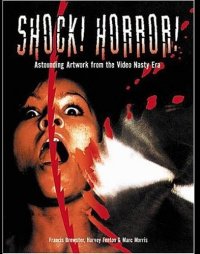
Written/Compiled by Francis Brewster, Harvey Fenton and Marc Morris.
Published by FAB Press (ISBN 1-903254-32-9) 2005.
- This book offers reviews, information and a compilation of the often shocking cover-art of the British Video Nasty era. During the early 1980s video tapes were a new and unrestricted medium in the UK and with the big commercial companies slow on the uptake, it was smaller firms that capitalised on the craze, releasing dozens of films that had previously been banned or censored for cinema release - competing for recognition the firms employed gorier and gorier cover art - and the "moral guardians" (ie. newspaper writers) of Britain soon took notice, encouraging a government crackdown that eventually lead to the BBFC being given control over video ratings in 1985.
- The
book is split into 2 main sections. Firstly, 168 full page, full colour
illustrations of the most lurid cover-art of the era - the images are
very high quality. The second half begins with a 5 page desciption of
the Video Nasty Era
and a timeline of the Director of Public Prosecution's "Banned List",
followed by details of all the films illustrated in the first half of
the book - including information on the original release format
(including run-time, release company and even the box type),
the film itself (including original title - many of the pre-cert videos
were released under bizarre alternative titles)
and a couple of paragraphs of notes. The book concludes with some
smaller images of alternate cover-art.
- Shock Horror is certainly of interest to anyone wanting to learn more about this often rather vaguely recorded period of cinema history, and the full page art-works are very impressive, although a lot of the information in the book is available on the internet.
- For more information on the video nasty era see Pre-Cert.co.uk, Melon Farmers and Hysteria Lives.
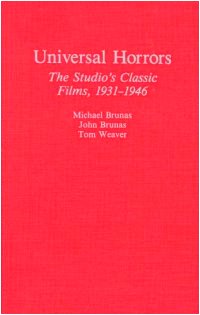
Written by Michael Brunas, John Brunas and Tom Weaver.
Published by McFarland & Company (ISBN 0-89950-369-1) 1991.
- This book provides a detailed filmography of the Universal Horror era. For over a decade, the comparatively small American studio shot dozens of horror films, from the iconic Frankenstein and Dracula (1931), to some lesser but equally loved trash in the forms of Frankenstein meets the Wolfman (1943) and The Mummy's Hand (1940).
- The
book provides a chronological, film-by-film look at the Universal
Horror cycle - including all the classic films,
as well as the studio's lesser known horror-style productions, the
Inner Sanctum films, and even the 12 Sherlock Holmes movies, starring
Basil Rathbone. Each film includes a complete cast/crew listing,
followed by several pages of commentary and information on production,
casting, censorship etc making it a perfect reference work. Despite the
very academic appearance of the book it is actually quite easy to read
and includes a good mix of information, quotes and editorial comments.
Lightly illustrated, most of the films include two full or half page
images.
- Offering a good mix of commentary and well researched information, and useful both as a reference work, and for casual reading, Universal Horrors is recommended to fans of the films and would make interesting reading to newcomers, although it carries a hefty price tag from most retailers that will probably deter all but the most hardcore fans.
- For more information on the era, see our Universal Horror pages.